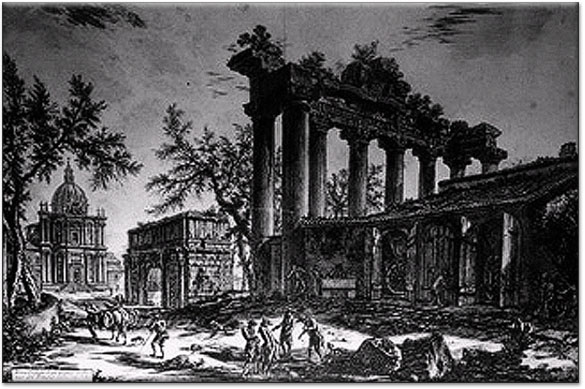The Role of Perspective in Shaping the Renaissance
Another example of the two-point perspective style is this view of the Temple
of Concordia by Piranesi (Fig. 14), one of his series of etchings on the ruins
of ancient Rome (ruins that are still viewable today). It is obvious that
oblique vanishing points to left and right have replaced the central vanishing
point of the Renaissance, although this simple modification was not appreciated
for 200 years after the central perspective came to the fore. The 18th century
finally saw effective control over the two-point perspective construction
that seemed to have eluded the artists of previous epochs.
 |
| Fig. 14. ‘Another View of the
Remains of the Pronaos of the Temple of Concordia’ by Piranesi
(1774). |
 |
Conclusion
This brief survey has sketched the outline of spatial representation over
two and a half millennia. It is the story of a struggle between inspiration
and geometric analysis. For much of the period, geometry was regarded with
the highest appreciation and yet the human mind was unable to get an adequate
grasp on the intricacies of this construction. Even though the central perspective
construction may have been perfected by the master exponents, attempts to
employ a more flexible construction seemed to be limited and rigid. The few
mathematical treatises that explored new modes of perspective failed to distill
them down to rules that could be employed by artists. Nevertheless, the interplay
between the power of perspective and the difficulty of its implementation
seems to have been one of the motivating forces through the Renaissance and
beyond. Even in the twentieth century, when perspective conventions were disregarded
or elaborated beyond recognition, the effects have often played off the yoke
of perspective realism that came to dominate most 18th and 19th century art.
For or against, perspective has been a major influence throughout the history
of Western art.
